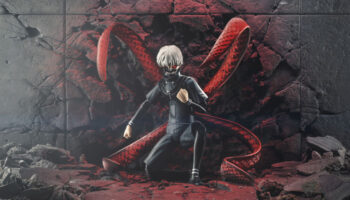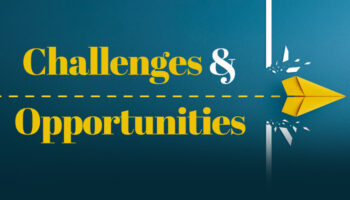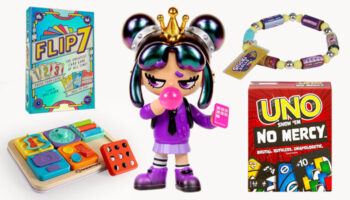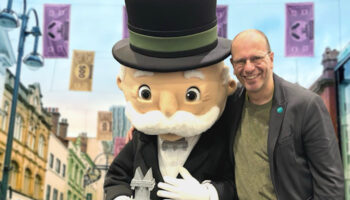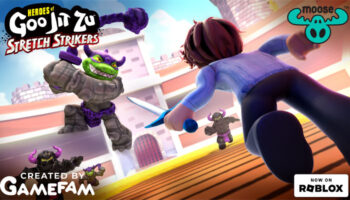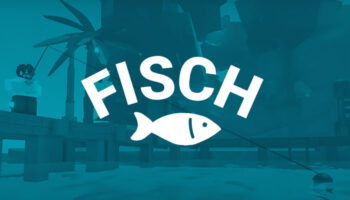“Game changer” or “Time trap”: Inventors and designers discuss the perks and pitfalls of AI-generated art

AI art generators is something of a divisive area at the moment.
Some praise them as game-changing ideation tools, others worry about the ramifications around ownership and whether AI could even threaten to replace designers in some sectors.
If anyone hasn’t played around with an AI art generator yet, you can get a flavour for the quality of images you can produce from the pictures above… We typed in the prompt ‘Toy Inventor’ to get those, just in case you’re wondering if we went with ‘Bald Bearded Guy Tinkering With Robots’.
So, should designers and inventors working in the toy and game industry embrace AI? And are its benefits limited to ideation, or could AI-generated visuals boost a concept’s chances in a pitch?
We asked figures in the industry for their thoughts…
Dan Klitsner, Founder, KID Group
I think AI art and ideation is the future because it’s like the 3D printer revolution – but for your brain! Learn to use it like a tool; like you would any other that has appeared in the last 20 years. It’s going to get to the point that if you can describe it, AI can visualise it and show you variations that would’ve taken you hours to create. With the right prompts and an experienced game designer, it’s a game changer for idea generation.
Westley Ciaramella, Partner, Catapult Concepts
I do enjoy the stylised imagery that can be generated from AI. Though for invention, I typically like to infer what I am looking at to imagine something new and different. Telling an AI to create my vision isn’t as useful as, say, just a general Google image search.
Luc Hudson, Co-Founder, Triclops Studio
I am torn between diving in and seeing what all the fuss is about and steering well clear because I don’t feel like I need to generate artwork from other people’s original material when I can draw myself. The hope is that the current situation will play out like when Photoshop was first unveiled and photographers feared for their livelihoods. What actually happened was that amateurs went to town with the one-click filters so that lots of work looked over-produced and samey – glamour over talent. Photoshop’s usage has morphed into a must-have complimentary tool for drawing, compositing and colouring, but it still needs a competent creative to get the best out of it.
Rob Ames, Co-Founder, Triclops Studio
When 3D printers first came about it was scary for the toy industry… “Everyone will have one and they’ll just print their own toys at home!” Obviously, that didn’t come to pass because people quickly realised that the skill is in CAD modelling whatever you’re printing, sanding it for a few hours to get it smooth, painting it and assembling it. You still have to have the skills to create. The AI tools are definitely shortcuts but it feels like without an innovative mind to set the parameters, the results will just be like an enhanced Google search. Coercing or interpreting the results into something cool and tangible is where the skill lies.
I’ll leave you with a Charlie Bucket analogy… Mr. Bucket was laid off from the toothpaste factory because the machines were faster – but then he was re-employed to fix the machines which kept breaking down.
Rebecca Bleau, Lead Designer, BlueMatter Games
AI has already become an important prototyping tool to help us iterate our prototypes to convey ideas. We design a lot of experiential games and we can’t just use random images. We need each image to serve a specific purpose, so we still have to have a deep understanding of tools like Adobe Photoshop and Illustrator for AI to be effective. AI is enhancing our creative process, not replacing it.
Gary Pyper, Founder, Fun-Damental Invention
I draw comparisons with the emergence of AI as a design tool with the emergence of 3D CAD visualisation in the early 2000s. Back then, as a tech luddite, I remember walking the halls of New Designers, chastising student presentations for being soulless. These new products appeared formulaic and bland, limited by the constraints of the software that produced them. But as the tools developed and our engagement with those tools changed, so did the output.
My experimentation with AI concept generation is comparable. My output to date is uneasily juxtaposed, having the air of the “unreal” and in turn, conceptually unconvincing – but it’s early days. Morally, the regurgitation of other creators’ assets is dubious and contentious, but is it any different to the internal process, of inspiration, mimicry and physical recreation? Unlike AI, I use my empathic human intelligence to visually connect with my customer.
Undoubtedly, it’s a powerful tool, so the question is: who knows best? Me or my Mac? For the moment at least, I think we both do.
Darren Lee Philipson, Toy & Content Development Architect, design_lead_play_
I completely understand why AI-generated artwork is a divisive conversation at the moment. Personally, I am a huge proponent of AI, specifically Midjourney. I think the best way to look at something like Midjourney is to consider it as another tool in your tool belt, similar to how Photoshop, Illustrator, Keynote and SolidWorks have become staples for most designers. Whereas I would typically use the internet to research and provide inspiration images to my clients, I now use Midjourney, which gives me a much more focused and ownable visual. There is a definite artform to using AI and creating visuals that meet your needs. I do think the output is only as good as the input – the way you structure your descriptions is key.
I’m excited about the idea of being able to create a visual in AI and the software is then able to produce the various views in order to print a 3D model… I guarantee this is in the works and coming to our digital devices soon! It will not be long before we start seeing postings for AI product designers.
AI design is here to stay and will continue to advance, both from a technological and practical point of view. I would advise all designers and inventors to embrace the technology and learn how to use it to your benefit… By the way, I am only saying all this as I know the robots are listening!
Fi O’Malley, Director, Making Things Studio
We’ve played around with it, but it won’t become a staple in our creative process right now. We need to be in the business of ‘1+1 = 3 thinking’, not ‘1+1 = 2 thinking’ – essentially everyone getting the same output if you input a couple of words.
It’s a phenomenal piece of tech but one that’s shrouded in legality issues. For us, ‘mash ups’ of art forms and visuals is just one small piece of a very big ideation pie. We aspire to create original, strategic and commercial creations.
That being said, competition is healthy – even if it’s a computer – and it’s given a ‘creative voice’ to those who typically couldn’t produce that level of visual output. The Nike x Tiffany’s launch was a great example of this. Did the timing of Nike putting out what some fans deemed a lacklustre collaboration with Tiffany’s propel AI in stardom while bloating it as a creative superpower? There’s no denying Nike had the creative talent in-house to create what the AI could, and more!
Hopefully, rather than enraging fans of brands amid the media hype of AI replacing creative jobs, AI can instead have a positive “we’d love to see this version” twist to it. Who knows, maybe they’ll be AI community-created sneakers coming to market sooner than we know it – if not already? I haven’t been on Google yet today to check… I’m out and about collecting inspiration for my brain that no AI machine could conjure – the competition is on, bot!
Kasper Lapp, Game Designer (Magic Maze, That’s Not a Hat, Fun Facts)
It’s been incredible to follow the development of the AI art generators. I have already used many different ones for a lot of prototypes. The most useful case has been art for a Dixit-style game where pictures are a central part of the game – I needed some dream-like pictures. It would have been difficult to find those without AI.
The most fun use has been for a game where I have different combinations of animals, such as a frog-elephant or a tiger-crab.I would not have been able to find images of those anywhere else. That said, it wasn’t really necessary for the gameplay and the game was fine without the images, so I’m not sure that AI art really did me a favour there.
AI art can be a great tool for a game designer, but it can also be a time trap. I have always tried not to spend too much time on art for my prototypes, since publishers should – at least in principle – be able to see through it. And even though AI art is theoretically just ‘write a prompt and get a picture’, in practice you will often end up trying out a lot of different prompts, creating variations and so on.
AI art at the current level is often ‘good, but not perfect’. There are always little details that could be improved, so you have to set your bar at a reasonable level in order not to spend too much time on it.
Nicholas Cravotta, Lead Developer, BlueMatter Games
With more complex games, identifying blind spots and balancing strategies can be time-consuming and require months of focused playtesting. We’re looking forward to when we can build an AI to win the game, then build another AI to beat the first one. If one AI keeps winning because of a particular strategy, we can debuff cards or resources to restore the balance.
Adam Borton, Founder, Creating Unique Toys
Any new tool that helps to create toys and games should definitely be looked at, not dismissed. There are many examples in recent toy and game history of people resting on their laurels and their existing skills or knowledge becoming obsolete.
After you’ve tried it out and become good enough to use it competently, you can ask some basic questions before deciding whether it’s something you should continue to learn about. Firstly, before any other question, will it contribute to increasing the quality of your work, either directly or indirectly? If not, then it’s not worth adding to your workflow. Secondly, if it will increase the quality of your work, will it also increase the speed of creating that quality? Not just speed gained through regular use, but is the tool itself faster than existing methods?
I have tried out many of the main text and image generation AI tools, such as ChatGPT, Dall-E and Midjourney. In terms of quality, learning to input the correct question to get a valuable, correct answer is something that needs experience in the speciality – in our case, toys and games. Otherwise, you end up fumbling in the dark and getting bland, generic answers.
Crafting a unique, high-quality toy or game that sells for a long period of time is not a matter of simply coming up with a cool-sounding idea and making it… Even with the help of AI, it’s a lot more involved than that. AI can be used as a tool to fuel ideas quickly, but it’s not a solution to all your creative problems. If you invest your time creating a toy or game based on what AI told you, without knowing whether it’s actually a good idea to work on it – including safety, value and manufacturability to name a few – you may end up wasting a lot of your valuable time and money. It’s like following Google Maps into a lake or leaving Tesla Autopilot on while having a snooze!
Trusting AI with these important decisions at every stage without human experience, intuition or creativity could end up with undesired consequences. It may give surface-level results, but it’s in-depth knowledge and experience that really makes the biggest difference.
Skylar Cravottableau, Developer, BlueMatter Games
I love AI. It has a ton of potential as a super useful tool for prototyping to make something look good without investing a lot of time or money. We’re looking forward to 3D AI. Today, if we want to model a 3D chicken robot for a game component, we have to find a chicken model and a robot model, then blend them together. Soon we’ll be able to prompt a chicken robot and get there much faster!
Courtney Wood, Founder & Director, Bubblegum Stuff
My team use it to get initial inspiration for their mood boards when trying to create a game. It won’t replace my design team but it will 100% help assist and speed up their work.
Geizi Guevara, Creative Design Manager, Jazwares BlueJ team
AI is a great tool for us at Jazwares when used wisely and considerately. We believe AI can give a designer unique and creative visuals to help expand their thinking. It challenges our people to get out of traditional design languages. However, the most critical thing is that it is inspiration only. Other tools like Photoshop or Illustrator are still incredibly important to make sure the ideas are communicated and designed exactly as imagined.
Most toy companies are looking for innovation, and a lot of that tends to be wows in mechanisms, transformations or chemistries. Where Jazwares finds that AI shines the most is visual artistry. You need a deft hand to really focus on pairing away AI debris and getting the results that are in your hand onto the page. AI tools are great thought starters, but don’t neglect the human touch and skills that you can develop in image editing. Ultimately, a designer’s eye and expertise are needed to bring ideas to life as this new technology develops.
Joseph Moll, VP Design, Development and Inventor Relationns, Crayola
This is great topic and does raise some controversy. We’ve tried it out and it’s interesting what we got out of it. If inventors use AI in the ideation process, it throws up questions around who actually owns the ideas, if they got it from AI… I think it’s likely best used as inspiration only; a creative tool rather than something to depend on for your final concept.
Brent Geppert, Senior Product Manager, Educational Insights
Here at Eductional Insights, we are already utilising AI tools like ChatGPT in terms of our process for social media posts, writing copy and research. In my role as product developer, I have used ChatGPT to start brainstorming concepts. I find it to be a great ideas soup starter. I have also – on a personal note – a few weeks ago started a T-shirt business using AI-generated art via Midjourney – see shameless plug: https://konacatcreationz.threadless.com/.
So yes, my point is I wholeheartedly think inventors and all creatives should embrace this technology. It’s almost like asking in 1994 if folks should embrace the “worldwide web”. The answer in retrospect would be “of course, how could we not use this new technology?” I am sure you’re aware the next version and future versions of AI tools will be even more powerful, mind blowing and disruptive – the sooner we all jump on board the better.
–
To stay in the loop with the latest news, interviews and features from the world of toy and game design, sign up to our weekly newsletter here






